

The challenging Edge: Dell Technologies to the rescue with Azure Stack Hub – Tactical
Mon, 26 Jul 2021 12:46:04 -0000
|Read Time: 0 minutes
Some context for a turbulent environment
In August 31, 2017, Microsoft launched Azure Stack Hub and enabled a true hybrid cloud operating model to extend Azure services on-premises. An awesome and long expected milestone at that time!
Implementing Azure Stack Hub in our customers’ datacenters under normal circumstances is a pretty straightforward process today if you choose our Dell EMC Integrated System for Microsoft Azure Stack Hub.
But there are certain cases where delivering Azure Stack Hub may be complex (or even impossible), especially in scenarios such as:
 Edge scenarios: semi-permanent or permanent sites where there is no planned decommissioning, that can include:
Edge scenarios: semi-permanent or permanent sites where there is no planned decommissioning, that can include:
- IoT Applications: Device provisioning, tracking and management applications
- Efficient field operations: Disaster Relief, humanitarian efforts, embassies
- Smarter management of mobile fleet assets: Utility and maintenance vehicles

- Tactical scenarios: strategic sites stood up for a specific task, temporary or permanent, that can experience:
- Limited/restricted connectivity: submarines, aircraft, and planes
- Harsh Conditions: combat zones, oil rigs, mine shafts
The final outcome in these environments remains the same: provide always-on cloud services everywhere from a minimal set of local resources.
The question is… how do we make this possible?
The answer is: Dell EMC Integrated System for Microsoft Azure Stack Hub – Tactical
Dell Technologies, in partnership with Microsoft and Tracewell Systems, has developed Dell EMC Integrated System for Microsoft Azure Stack Hub – Tactical (aka Azure Stack Hub – Tactical): a unique ruggedized and field-deployable solution for Azure Stack tactical edge environments.
Azure Stack Hub – Tactical extends Azure-based solutions beyond the traditional data center to a wide variety of non-standard environments, providing a local Azure consistent cloud with:
- Limited or no network connectivity
- Fully mobile, or high portability (“2-person lift”) requirements
- Harsh conditions requiring military specifications solutions
- High security requirements, with optional connectivity to Azure Government and Azure Government Secret
Azure Stack Hub – Tactical is functionally and electrically identical to Azure Stack Hub All-Flash to ensure interoperability. It includes custom engineered modifications to make the whole solution fit into just three ruggedized cases that are only23.80 inches wide, 41.54 inches high, and 25.63 inches deep.
The smallest Azure Stack Hub – Tactical configuration comprises one management case plus two compute cases, each of them containing:
- Management case:
- 1 x T-R640 HLH management server (2U)
- 1 x N3248TE-ON management switch (1U)
- 2 x S5248F-ON Top-of-Rack switches (1U each)
- Total weight: 146 lbs.
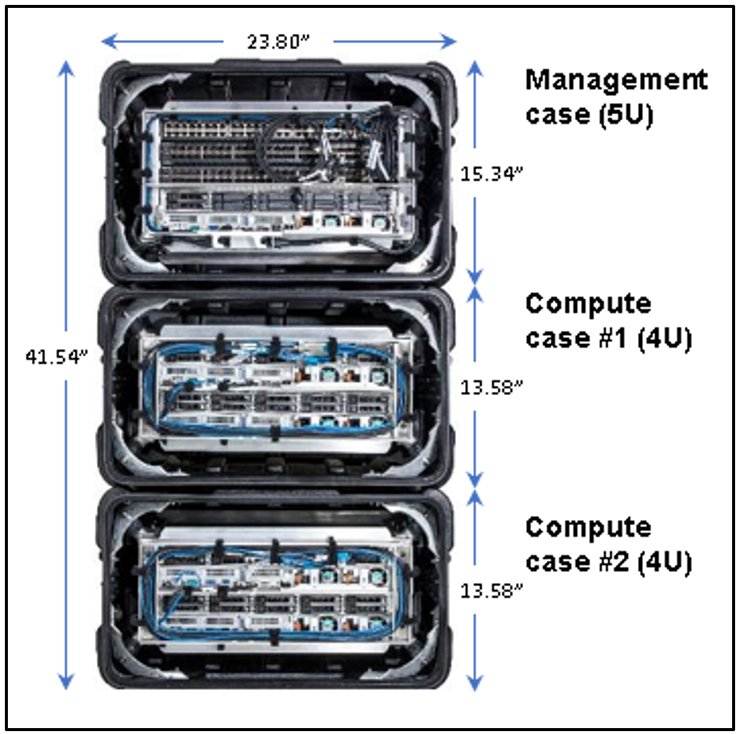
- Compute case:
2 x T-R640 servers, based on Dell EMC PowerEdge R640 All-Flash server adapted for tactical use (2U each)
Two configuration options for compute servers:
- Low:
- 2 x Intel 5118 12-core processors
- 384 GB memory
- 19.2TB total raw SSD capacity
- High:
- 2 x Intel 6130 16-core processors
- 768GB memory
- 38.4TB total raw SSD capacity
- Total weight: 116 lbs.
- Heater option for extended temperature operation support:
- The Tactical devices are designed to meet MIL-STD-810G specification
- Dell Technologies in collaboration with Tracewell systems has designed a fully automated heater which, when fully integrated, can provide supplemental heating to the device when needed.
Compute cases can grow up to 8, for a total of 16 servers (in 4-node increments) -- the scale unit maximum mandated by Microsoft.
You can read the full specifications here.
Azure Stack Hub – Tactical is a turnkey end to end engineered solution designed, tested, and sustained through the entire lifespan of all of its hardware and software components.
It includes non-disruptive operations and automated full stack life cycle management for on-going component maintenance, fully coordinated with Microsoft’s Update process.
Customers also benefit from a simplified one call support model across all solution components.
Conclusion
Desperate “edge-cuts” must have desperate “tactical-cures”, and that is exactly what Dell EMC Integrated System for Microsoft Azure Stack Hub – Tactical delivers to our customers for edge environments and extreme conditions.
Azure Stack Hub – Tactical resolves the challenges of providing Azure cloud services everywhere by allowing our customers to add/remove deployments with relative ease through an automated, repeatable, and predictable process requiring minimal local IT resources.
Thanks for reading and stay tuned for more blog updates in this space by visiting Info Hub!
Related Blog Posts

Technology leap ahead: 15G Intel based Dell EMC Integrated System for Microsoft Azure Stack HCI
Wed, 22 Sep 2021 18:15:33 -0000
|Read Time: 0 minutes
We are happy to announce the latest members of the family for our Microsoft HCI Solutions from Dell Technologies: the new AX-650 and AX-750 nodes.
If you are already familiar with our existing integrated system offering, you can directly jump to the next section. For those new to the party, keep on reading!
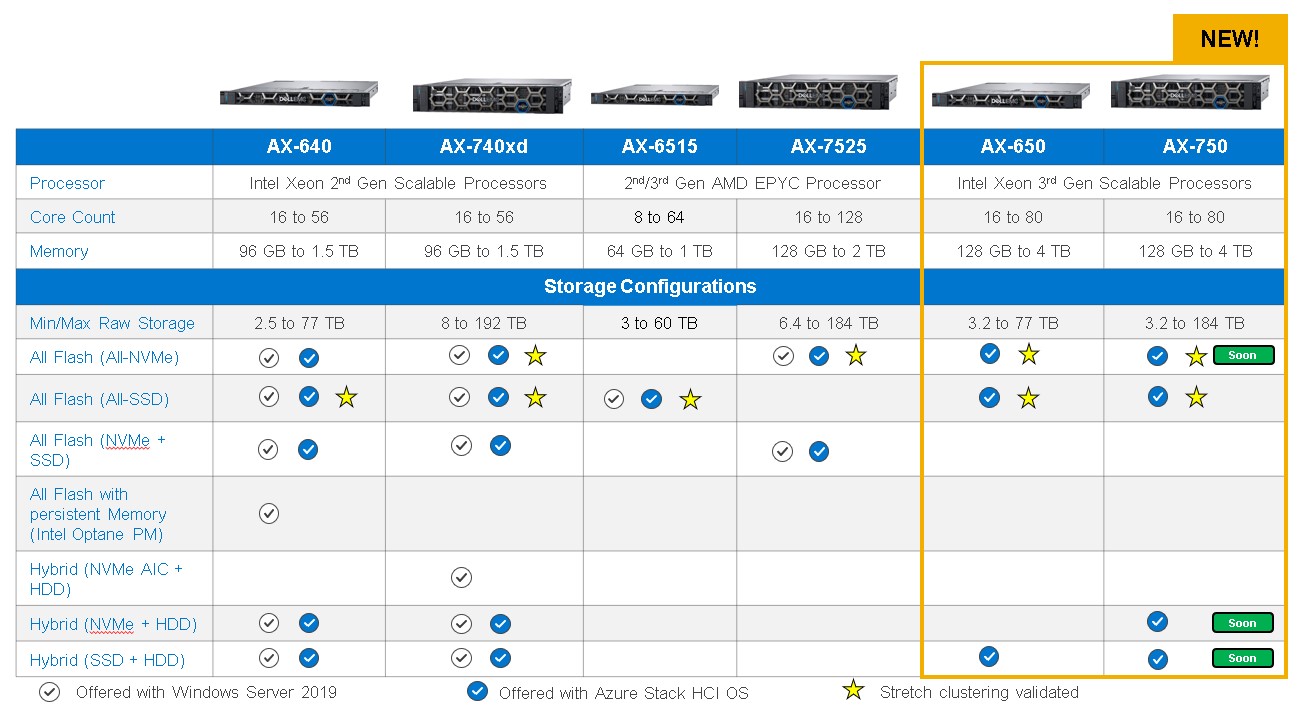
Figure 1: Dell EMC Integrated System for Microsoft Azure Stack HCI portfolio: New AX-650 and AX-750 nodes
As with all other nodes supported by Dell EMC Integrated System for Microsoft Azure Stack HCI, the AX-650 and AX-750 nodes have been intelligently and deliberately configured with a wide range of component options to meet the requirements of nearly any use case – from the smallest remote or branch office to the most demanding database workloads.
The chassis, drive, processor, DIMM module, network adapter, and their associated BIOS, firmware, and driver versions have been carefully selected and tested by the Dell Technologies engineering team to optimize the performance and resiliency of Azure Stack HCI. Our engineering has also validated networking topologies using PowerSwitch network switches.
Arguably the most compelling aspect of our integrated system is our life cycle management capability. The Integrated Deploy and Update snap-in works with the Microsoft cluster creation extension to deliver Dell EMC HCI Configuration Profile. This Configuration Profile ensures a consistent, automated initial cluster creation experience on Day 1. The one-click full stack life cycle management snap-in for the Microsoft Cluster-Aware Updating extension allows administrators to apply updates. This seamlessly orchestrates OS, BIOS, firmware, and driver updates through a common Windows Admin Center workflow.
On top of it, Dell Technologies makes support services simple, flexible, and worry free – from installation and configuration to comprehensive, single source support. Certified deployment engineers ensure accuracy and speed, reduce risk and downtime, and free IT staff to work on those higher value priorities. Our one-stop cluster level support covers the hardware, operating system, hypervisor, and Storage Spaces Direct software, whether you purchased your license from Dell EMC or from Microsoft.
Now that we are at the same page with our integrated system…
What’s new with AX-650 and AX-750? Why are they important for our customers?
AX-650 and AX-750 are based on Intel Xeon Scalable 3rd generation Ice Lake processors that introduce big benefits in three main areas:
- Hardware improvements
- New features
- Management enhancements
Hardware improvements
Customers always demand the highest levels of performance available, and our new 15G platforms, through Intel Ice Lake and its latest 10nm technology, deliver huge performance gains (compared to the previous generation) for:
- Processing: up to a 40 percent CPU performance increase, a 15 percent per core performance boost, and 42 percent more cores
- Memory: 33 percent more memory channels, a 20 percent frequency boost, and a 2.66x increase in memory capacity
- PCIe Gen4 IO acceleration: a doubled throughput increase compared to PCIe Gen3, 33 percent more lanes, an increase in direct attached Gen4 NVMe drives, and support for the latest Gen4 accelerators and GPUs
These impressive figures are a big step forward from a hardware boost perspective, but there are even more important things going on than just brute power and performance.
Our new 15G platforms lay the technology foundation for the latest features that are coming (really) soon with the new version of Microsoft Azure Stack HCI.
New features
Windows Server 2022 and Azure Stack HCI, version 21H2 will bring in (when they are made available) the following two key features:
- Secured-core Server
- GPU support
The fundamental idea of Secured-core Server is to stay ahead of attackers and protect our customers’ infrastructure and data all through hardware, BIOS, firmware, boot, drivers, and the operating system. This idea is based on three pillars:
- Simplified security: easy integration and consumption through Windows Admin Center
- Advanced protection: leveraging hardware root-of-trust, firmware protection, and virtualization-based security (VBS)
- Preventative defense: proactively block the paths attackers use to exploit a system
For more details about Secured-core Server, click here.

Figure 2: Secured-core Server with Windows Admin Center integration
AX-650, AX-750, and AX-7525 are the first AX nodes to introduce GPU readiness for single-width and double-width GPUs.
With the September 21, 2021 launch, all configurations planned to support GPUs are already enabled in anticipation for the appropriate selection of components (such as GPU risers, power supplies, fans, and heatsinks).
This process permits the GPU(s) to be added later on (when properly validated and certified) as an After Point of Sale (APOS).
The first GPU that will be made available with AX nodes (AX-650, AX-750, and AX-7525) is the NVIDIA T4 card.
To prepare for this GPU, customers should opt for the single-width capable PCI riser.
The following table shows the maximum number of adapters per platform taking into account the GPU form factor:
| AX-750 | AX-650 | AX-7525 | |||
| Single width | Dual width | Single width | Dual width | Single width | Dual width |
All SSD | Up to 31 | Up to 2 | Up to 22 | N/A |
| |
All NVMe | Up to 31 | Up to 2 | Up to 22 | N/A | Up to 33 | Up to 33 |
NVMe+SSD |
| Up to 4 | Up to 3 | |||
1 Max of 3 factory installed with Mellanox NIC adapters. Exploring options for up to 4 SW GPUs
2 Depending on the number of RDMA NICs
3 Only with the x16 NVMe chassis. x24 NVMe chassis does not support any GPUs
Note that no GPUs are available at the September 21, 2021 launch. GPUs will not be validated and factory installable until early 2022.
Management enhancements
Dell EMC OpenManage Integration with Microsoft Windows Admin Center (OMIMSWAC) extension was launched in 2019.
It has included hardware and firmware inventory, real time health monitoring, iDRAC integrated management, troubleshooting tools, and seamless updates of BIOS, firmware, and drivers.
In the 2.0 release in February 2020, we also added single-click full stack life cycle management with Cluster-Aware Updating for the Intel-based Azure Stack HCI platforms. This allowed us to orchestrate OS, BIOS, firmware, and driver updates through a single Admin Center workflow, requiring only a single reboot per node in the cluster and resulting in no interruption to the services running in the VMs.
With the Azure Stack HCI June 2021 release, the OpenManage Integration extension added support for the AX-7525 and AX-6515 AMD based platforms.
Now, with the September 21, 2021 launch, OMIMSWAC 2.1 features a great update for AX nodes, including these important extensions:
- Integrated Deploy & Update
- CPU Core Management
- Cluster Expansion
Integrated Deploy & Update deploys Azure Stack HCI with Dell EMC HCI Configuration Profile for optimal cluster performance. Our integration also adds the ability to apply hardware solution updates like BIOS, firmware, and drivers at the same time as operating system updates as part of cluster creation with a single reboot.
With CPU Core Management, customers can dynamically adjust the CPU core count BIOS settings without leaving the OpenManage Integration extension in Windows Admin Center, helping to maintain the right balance between cost and performance.
Cluster Expansion helps to prepare new cluster nodes before adding them to the cluster, to significantly simplify the cluster expansion process, reduce human error, and save time.
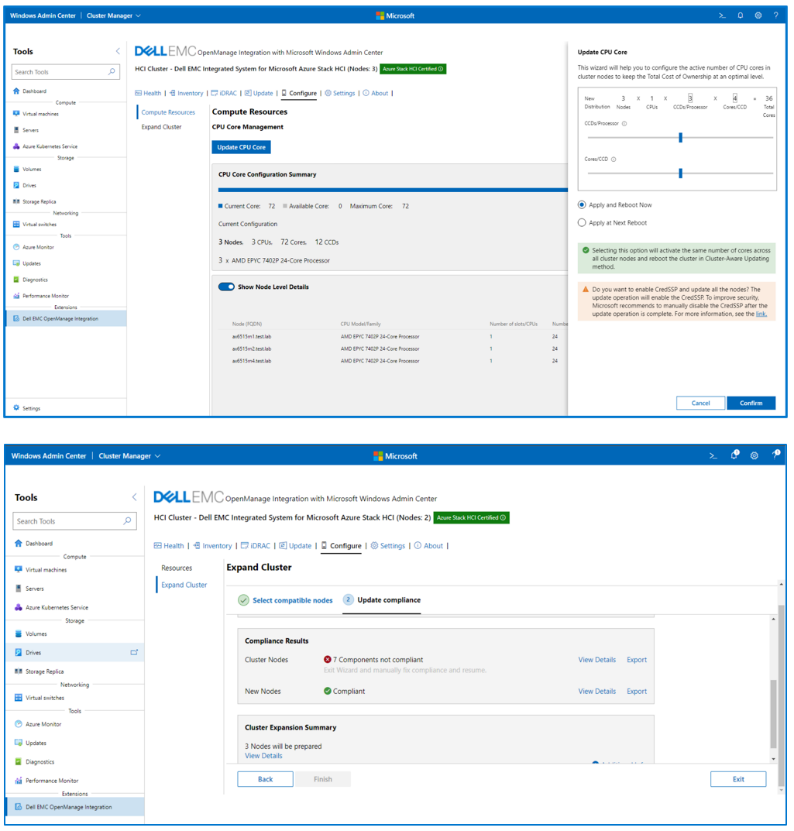
Figure 3: CPU Core Management and Cluster Expansion samples
In conclusion, the AX-650 and AX-750 nodes establish the most performant and easy to operate foundation for Azure Stack HCI today, along with all the new features and goodness that Microsoft is preparing. Stay tuned for more news and updates on this front!
Author Information
Ignacio Borrero, @virtualpeli

GPU-Accelerated AI and ML Capabilities
Mon, 14 Dec 2020 15:37:06 -0000
|Read Time: 0 minutes
Dell EMC Integrated System for Microsoft Azure Stack Hub has been extending Microsoft Azure services to customer-owned data centers for over three years. Our platform has enabled organizations to create a hybrid cloud ecosystem that drives application modernization and to address business concerns around data sovereignty and regulatory compliance.
Dell Technologies, in collaboration with Microsoft, is excited to announce upcoming enhancements that will unlock valuable, real-time insights from local data using GPU-accelerated AI and ML capabilities. Actionable information can be derived from large on-premises data sets at the intelligent edge without sacrificing security.
Partnership with NVIDIA
Today, customers can order our Azure Stack Hub dense scale unit configuration with NVIDIA Tesla V100S GPUs for running compute-intensive AI processes like inferencing, training, and visualization from virtual machine or container-based applications. Some customers choose to run Kubernetes clusters on their hardware-accelerated Azure Stack Hub scale units to process and analyze data sent from IoT devices or Azure Stack Edge appliances. Powered by the Dell EMC PowerEdge R840 rack server, these NVIDIA Tesla V100S GPUs use Discrete Device Assignment (DDA), also known as GPU pass-through, to dedicate one or more GPUs to an Azure Stack Hub NCv3 VM.
The following figure illustrates the resources installed in each GPU-equipped Azure Stack Hub dense configuration scale unit node.
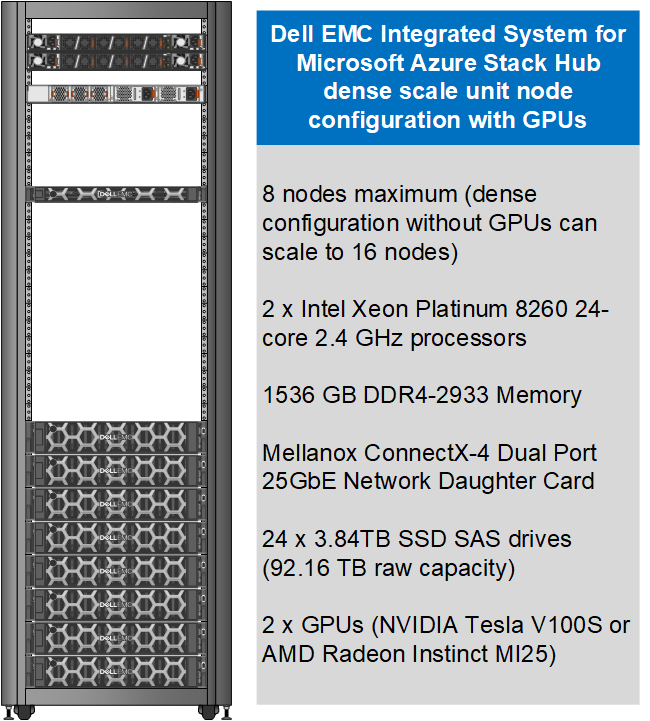
This month, our Dell EMC Azure Stack Hub release 2011 will also support the NVIDIA T4 GPU – a single-slot, low-profile adapter powered by NVIDIA Turing Tensor Cores. These GPUs are perfect for accelerating diverse cloud-based workloads, including light machine learning, inference, and visualization. These adapters can be ordered with Dell EMC Azure Stack Hub all-flash scale units powered by Dell EMC PowerEdge R640 rack servers. Like the NVIDIA Tesla V100S, these GPUs use DDA to dedicate one adapter’s powerful capabilities to a single Azure Stack Hub NCas_v4 VM. A future Azure Stack Hub release will also enable GPU partitioning on the NVIDIA T4.
The following figure illustrates the resources installed in each GPU-equipped Azure Stack Hub all-flash configuration scale unit node.
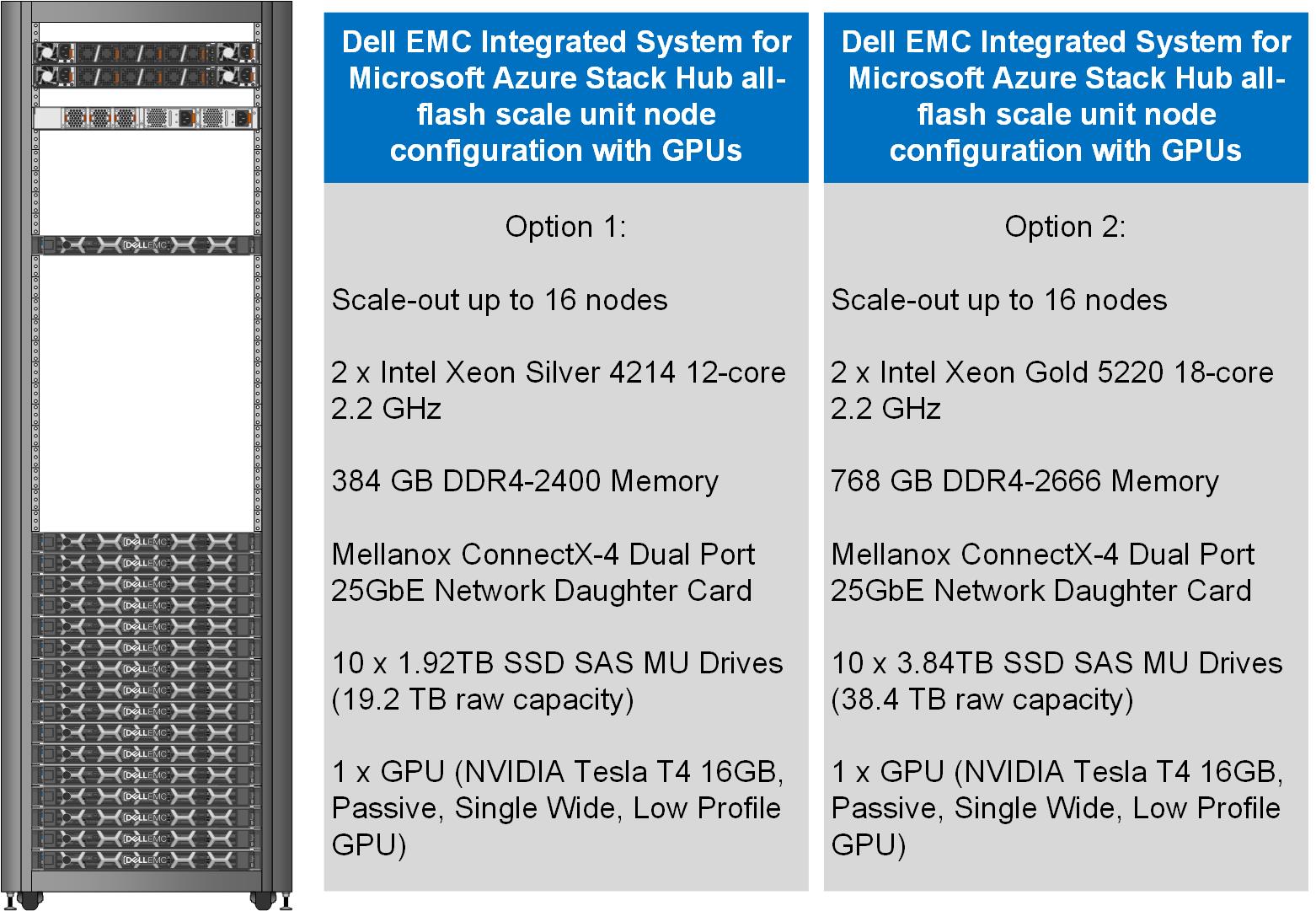
Partnership with AMD
We are also pleased to announce a partnership with AMD to deliver GPU capabilities in our Dell EMC Integrated System for Microsoft Azure Stack Hub. Available today, customers can order our dense scale unit configuration with AMD Radeon Instinct MI25 GPUs aimed at graphics intensive visualization workloads like simulation, CAD applications, and gaming. The MI25 uses GPU partitioning (GPU-P) technology to allow users of an Azure Stack Hub NVv4 VM to consume only a portion of the GPU’s resources based on their workload requirements.
The following table is a summary of our hardware acceleration capabilities.
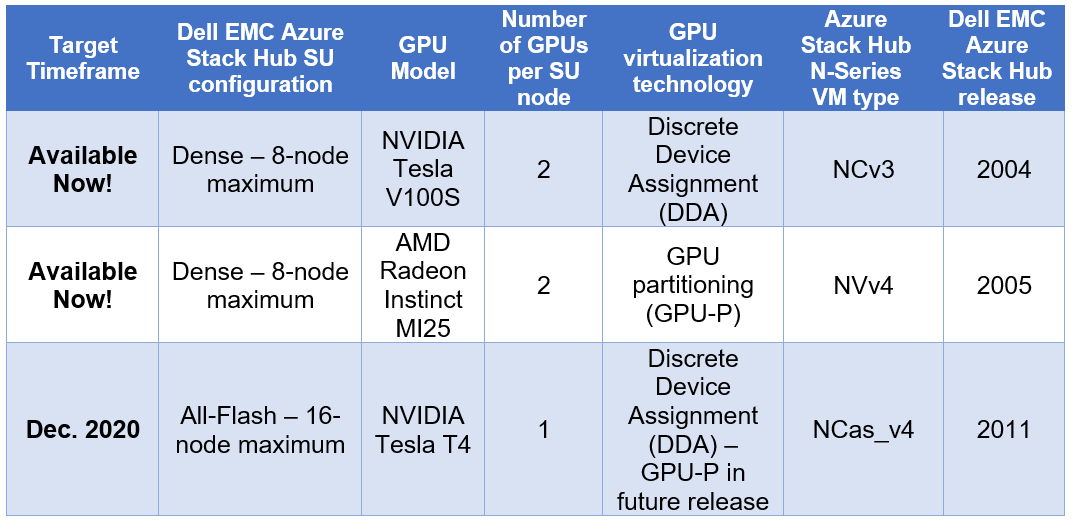
An engineered approach
Following our stringent engineered approach, Dell Technologies goes far beyond considering GPUs as just additional hardware components in the Dell EMC Integrated System for Microsoft Azure Stack Hub portfolio. We apply our pedigree as leaders in appliance-based solutions to the entire lifecycle of all our scale unit configurations. The dense and all-flash scale unit configurations with integrated GPUs are designed to follow best practices and use cases specifically with Azure-based workloads, rather than workloads running on traditional virtualization platforms. Dell Technologies is also committed to ensuring a simplified experience for initial deployment, patch and update, support, and streamlined operations and monitoring for these new configurations.
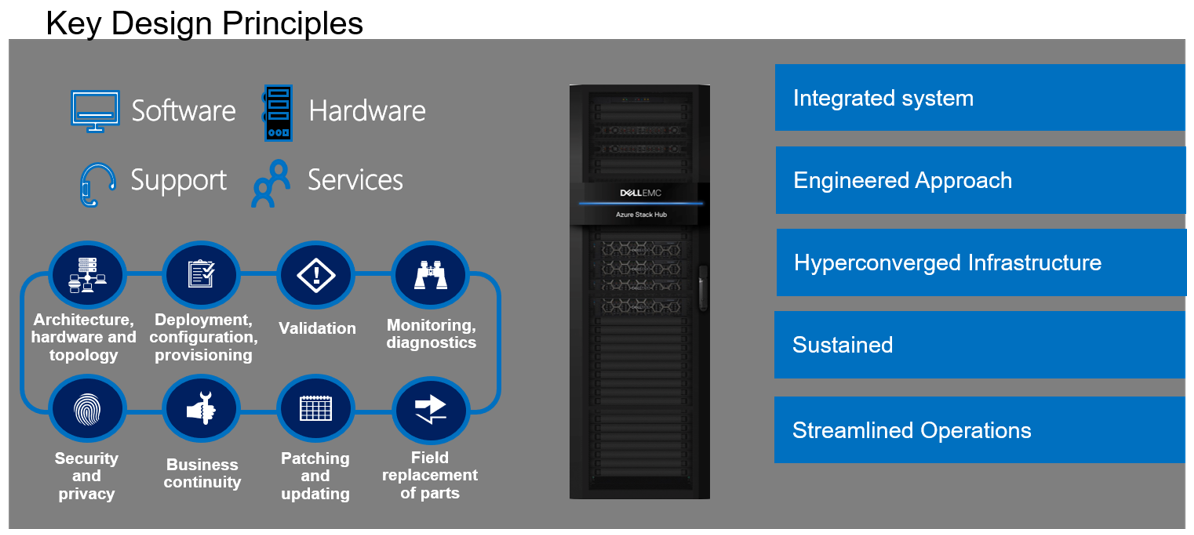
Additional considerations
There are a couple of additional details worth mentioning about our new Azure Stack Hub dense and all-flash scale unit configurations with hardware acceleration:
- The use of the GPU-backed N-Series VMs in Azure Stack Hub for compute-intensive AI and ML workloads is still in preview. Dell Technologies is very interested in speaking with customers about their use cases and workloads supported by this configuration. Please contact us at mhc.preview@dell.com to speak with one of our engineering technologists.
- The Dell EMC Integrated System for Microsoft Azure Stack Hub configurations with GPUs can be delivered fully racked and cabled in our Dell EMC rack. Customers can also elect to have the scale unit components re-racked and cabled in their own existing cabinets with the assistance of Dell Technologies Services.
Resources for further study
- At the time of publishing this blog post, only the NCv3 and NVv4 VMs are available in the Azure Stack Hub marketplace. The NCas_v4 currently is not visible in the portal. Please proceed to the Azure Stack Hub User Documentation for more information on these VM sizes.
- Customers may want to explore the Train Machine Learning (ML) model at the edge design pattern in the Azure Hybrid Documentation. This may prove to be a good starting point for putting this technology to work for their organization.
- Customers considering running AI and ML workloads on Dell EMC Integrated System for Microsoft Azure Stack Hub can also greatly benefit from storage-as-a-service with Dell EMC PowerScale. PowerScale can help enable faster training and validation of AI models, improve model accuracy, drive higher GPU utilization, and increase data science productivity. Visit Artificial Intelligence with Dell EMC PowerScale for more information.


